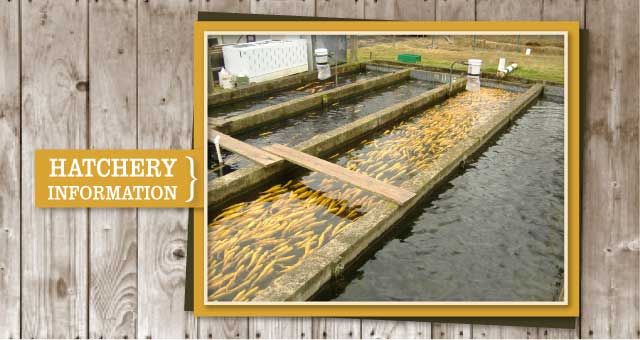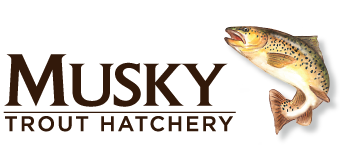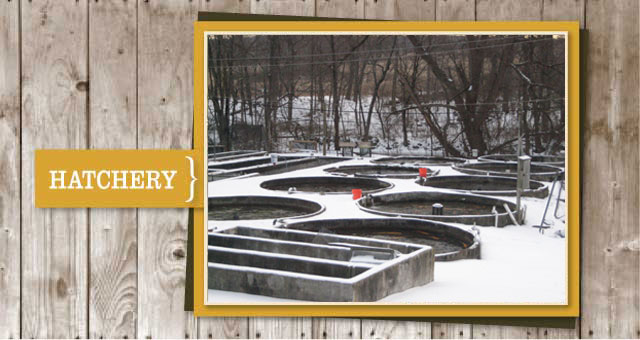Harper's Weekly. June 13, 1868
A NEW JERSEY FISH FARM.
The application of science to the artificial propagation and cultivation of fishes has lone been recognized as an art. Although it is of no recent date, having been practiced by Jacobt at Hanover over a century since, it has but recently received the attention which it deserves. The rediscovery of the process of artificial impregnation of ova by the Vogsgean fishermen, Gerin and remy, and the founding of the great National French Fish Farm at Huningue, on the Rhime, have resulted in the foundation in Europe of a vast number of fish-breeding establishments; but in this country the subject is only the beginning to receive the attention and legislation which it demands. A description of one of the fish farms of this country, that of Mr. Seth Green, situated near Caledonia, New York, was given in Harper's Magazine for December, 1867. On this page of the Weekly we present a series of illustrations representing a general view (with some details of the hatching process as there practiced) of the fish farm of Dr. J H. Slack, at Troutdale, near Bloomsbury, New Jersey, sixty-four miles southwest of New York city. The farm, comprising about sixty-eight acres, is in a high state of cultivation, as is the whole of the Muskanetkony Valley, in which is situated; the well kept fences and neat buildings, those never failing signs of industry, bearing witness to the prosperity of the residents.
THE SPRING.
The artificially-constructed ponds and buildings connected with the fish raising, covering in all about two acres, are situated on the right bank of the Muskanectkony Creek, which here forms the boundary between the counties of Warren and Hunerdon; the former being upon the right, the latter upon the left of the stream. These ponds are supplied with a pure crystal water from a large and beautiful spring, from which it flows in a continual stream at the rate of 1000 gallons per minute. This water is, in summer and winter, of the same temperature fifty degrees Fahrenheit and reaches the hatching-house and ponds at the same temperature. This is a matter of the greatest importance in fish hatching. In the spring there are about two hundred small trout, naturally bred. From the spring the water is led by a raceway and circulated through three ponds and a hatching-house. At various points gates or sluices are located, furnished in wire screens, which serve the purpose of preventing the escape of the fishes and of collecting leaves, sticks, or other articles which may accidentally find there way into the ponds. These screens are cleaned twice a day, except during the autumn, when the falling leaves from the trees which overshadow the spring necessitates more constant care.
The PONDS
The ponds at present contain about seven hundred adult trout, which a few were hatched during winter of 1866-67 by Mr. Rhaddeus Norris, the well-known angler and former proprietor of the ponds. Some of the fishes are marked by striking peculiarities, and have received distinguishing names. One is known as "Bartimeus," from the fact that he is totally blind, and perfectly black in color; "Lady Douglas" has one side of her head of the same sobriquet. A long, lean, lantern-jawed male is appropriately yelept " Don Quixote;" while a huge three pounder, who fought it out on the line during the entire spawning season, killing and devouring over a dozen large fishes, is called "General Grant." There was formerly in the large pond a curious parti-colored fish, with irregular spots and streaks of white and black, the colors varying almost weekly, who was known to some of the numerous Democrats in the vicinity as "Horace Greenley;" but he is now no more, having been unfortunately killed and eaten by "General Grant" in December last. The trout is a sad cannibal; "the dog," it is said, "will not eat dog;" but a trout of but one and a half inches will unhesitatingly seize and devour one of his own species two-thirds his own length. Various fishes over a foot long have disappeared from time to time down the capacious throat of "General Grant." On this account three ponds are necessary. The one nearest the hatching house is now being prepared for the reception of the twenty thousand young trout hatched at Troutdale during the past winter; the middle one is devoted to trout of eight inches and under, while in the third are placed the larger fishes, many of them of a size calculated to cause a lover of 'the gentle craft" to infringe upon the Tenth Commandment. The bottoms of the ponds are clay, upon which have been placed a number of large stones, in order that the trout, by rubbing against them, may free their bodies of the numerous parasites, animals and vegetation, which frequently infest them. Shade is afforded by large floats, secured to the bank by wires. The races are slated, to prevent the crumbling of the banks, their bottoms are being covered with small stones, upon which is placed a layer of fine gravel, though the latter is not plentiful in the vicinity.
THE HATCHING HOUSE
The Hatching House is situated upon the right bank of the first pond, and a neat lodge to the westward is occupied as a residence by the assistants.
FEEDING
The large trout are fed with curd, the offal from the slaughter-houses cut in fine pieces, and fishes, the latter sometimes living. During our visit two living red-fins about four inches in length (Leuciscus cornutus) were thrown into the pond; they were immediately seized by two huge trout, who at once retired to the lower end of the pond, there to swallow and digest them at their leisure. The gullets of the captors being shorter than their prey, over an hour elapsed before the tails of the red-fins vanished down the throats of the trout.
DR. SLACK'S EXPERIENCE
Dr. SLACK is a thorough lover of the art and the craft, and as he is also a thoroughly-educated naturalist, his experience and experiments in the artificial hatching of trout ova has a double value and increased interest, and we append it hereto, partly in explanation of some of our illustrations of the process of taking and hatching the eggs.
"About the middle of the month of October, 1857, it became evident that the spawning season was at hand. The colors of the adult fishes began to alter to an extent noticeable by the most unpracticed eye. Losing the bright tints with which they formerly bedecked, the female trout became dark and somber in color, putting on a grave and matronly dress. The hues of the males were, on the contrary, more brilliant than previously. Their general color became much lighter, and in the older individuals the lower jaw projected interiorly, forming a sort of knob. The distension of the abdomen of the females by the eggs caused the section of their body to assume the oval shape, while that of the male resembled the outline of the eye of a broad-axe. Fierce battles took place between the males, the conquer celebrating his victory by feasting upon the body of the vanquished; the females swam uneasily about the ponds, trying the bottom with their fins, seeking for gravel in which to deposit their eggs. The bottoms of the ponds being formed of clay and large stones, they were obliged to pass into the races for that reason. These have previously been prepared by covering their bottoms with fine gravel and placing across them obstructions, forming a series of dams and eddies.
On October 30 fishes were perceived in the race busily engaged in forming a nest for the reception of their eggs by removing the fine gravel from a circle of about a foot in diameter. Across the lower end of the raceway a net was quietly placed, and the gate at the race-head closed, by which the flow of water was stopped. To avoid being left high and dry, the fishes were obliged to pass down stream, and were thun captured in the net, the fishes being placed for the nonce in a large tin kettle. About a quart of pure spring water was placed in the impregnating pan; a male was then taken and held in the impregnating pan; a male was then taken and held in the manner depicted in the engraving, the left hand grasping the neck below he gills, and the right the body just behind the gills. By gentle pressure with the fore and middle fingers of the left hand a quantity of the milt was expressed, the amount being farther in, creased by gentle friction toward the tail. This was continued until the water became opalescent or pearly."


